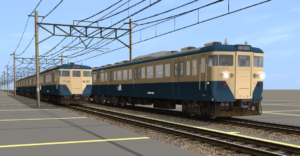
DOWNLOAD
This is a reskin of Keinchiro’s 113 Series upgraded by Hirochi. All the necessary dependencies are included in this package or are avaible on the DLS.
113 Series trains were introduced on the Yokosuka line in 1963, at the same time as 113s were introduced on the Tokaido Main Line.
Initially, these were also painted in the Shonan livery, but it was later changed to the popular blue and cream “Yokosuka Livery” of the 70 Series trains (that the 113s were to replace), to avoid passengers mistaking trains (at the time, and partially to this day, Tokaido Main Line and Yokosuka Line services share the same platforms). All the Yokosuka Line trains were repainted in the Yokosuka Livery by 1965.
Shortly later, in the late 1960s, JNR was in the midst of a general reorganisation of commuter and suburban services in the Greater Tokyo Metropolitan Area, called the “Five Commuting Directions” campaing, with among other things, planned the connection the Yokosuka and Sobu Lines as a single line via an underground link in order to reduce overcrowding on the two and traffic congestion at Tokyo Station.
In preparation for the opening of the underground link, a new variant of the 113 Series was introduced: the 113-1000 Series.
These were a modified version of the above-ground 113-0 Series in service on the Tokaido Line, as they were designed to run underground, they had to comply with the same stringent regulations already in use on subways, wich mandated, among other things, the complete elimination of all flammable materials and their replacement with ones that were non-flammable, or fire-retardant at best.
When the underground link opened in 1972, 113-1000 Series trains took over all the mainline duties of the 113-0s, wich were “relegated” to suburban, above-ground only duties in the Chiba area.
The transferred 113-0s were reformed in -3 and -4-car sets and entered service on the Narita, Sotobo, Uchibo and the newly-opened Kashima Line, replacing the substandard wartime and post-war built 72 Series, wich was replaced on all four lines by 1976.
Fast forward to the late 1990s, when the 113-1000s in service on the Yokosuka and Sobu Lines were being replaced by the E217 Series; displaced 113-1000s were also transferred to the Boso area lines, supplementing the 1963-vintage 113-0s.
From the mid-2000s onwards, the 113 Series were now old and obsolete, and as such, JR East planned a replacement.
Surplus 211 Series trains displaced by E231-1000s on Tokaido Line services were introduced to the Boso area in 2006, replacing the oldest units, but not all of them, as there weren’t enough units.
Finally, starting from 2009, the 209 Series on the Keihin-Tohoku Line was getting replaced by brand-new E233-1000s. Surplus 209s were reformed into -6 and -4 car sets and converted into 209-2200 Series trains for regional and local services, entering in service in the same year and replacing both the 113s and the 211s by 2011.
